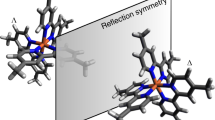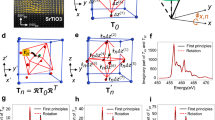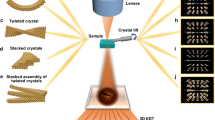Abstract
Resonant X-ray diffraction (RXD) uses X-rays in the vicinity of a specific atomic absorption edge and is a powerful technique for studying symmetry breaking by motifs of various multipole moments, such as electric monopoles (charge), magnetic dipoles (spin) and electric quadrupoles (orbital). Using circularly polarized X-rays, this technique has been developed to verify symmetry breaking effects arising from chirality, the asymmetry of an object upon its mirroring. Chirality plays a crucial role in the emergence of functionalities such as optical rotatory power and multiferroicity. Here we apply spatially resolved RXD to reveal the helix chirality of Dy 4f electric quadrupole orientations and its domain structure in DyFe3(BO3)4, which shows a reversible phase transition into an enantiomorphic space-group pair. The present study provides evidence for a helix chiral motif of quadrupole moments developed in crystallographic helix chirality.
This is a preview of subscription content, access via your institution
Access options
Subscribe to this journal
Receive 12 print issues and online access
$259.00 per year
only $21.58 per issue
Buy this article
- Purchase on Springer Link
- Instant access to full article PDF
Prices may be subject to local taxes which are calculated during checkout




Similar content being viewed by others
References
Wagnière, G. H. On Chirality and the Universal Asymmetry (Wiley–VCH, (2007).
Barron, L. D. Chirality and life. Space Sci. Rev. 135, 187–201 (2008).
Neumann, F. E. Vorlesungen über die Theorie der Elastizität der festen Körper und des Lichtäthers (B. G. Teubner-Verlag, (1885).
Condon, E. U. Theories of optical rotatory power. Rev. Mod. Phys. 9, 432–457 (1937).
Bijvoet, J. M., Peerdeman, A. F. & van Bommel, A. J. Determination of the absolute configuration of optically active compounds by means of X-rays. Nature 168, 271–272 (1951).
Lovesey, S. W. & Scagnoli, V. Chirality, magnetic charge and other strange entities in resonant X-ray Bragg diffraction. J. Phys. Condens. Matter 21, 474214 (2009).
Igarashi, J. & Takahashi, M. Resonant X-ray scattering from chiral materials: alpha-quartz and alpha-berlinite. Phys. Rev. B 86, 104116 (2012).
Tanaka, Y. et al. Right handed or left handed? Forbidden X-ray diffraction reveals chirality. Phys. Rev. Lett. 100, 145502 (2008).
Tanaka, Y. et al. Determination of structural chirality of berlinite and quartz using resonant X-ray diffraction with circularly polarized X-rays. Phys. Rev. B 81, 144104 (2010).
Tanaka, Y. et al. Determination of the absolute chirality of tellurium using resonant diffraction with circularly polarized X-rays. J. Phys. Condens. Matter 22, 122201 (2010).
Ohsumi, H. et al. Three-dimensional near-surface imaging of chirality domains with circularity polarized X-rays. Angew. Chem. 2013, 125 (2013).
Lovesey, S. W., Balcar, E., Knight, K. S. & Fernández Rodríguez, J. Electronic properties of crystalline materials observed in X-ray diffraction. Phys. Rep. 411, 233–289 (2005).
Lovesey, S. W., Balcar, E. & Tanaka, Y. Resonant diffraction of circularly polarized X-rays by a chiral crystal (low quartz). J. Phys. Condens. Matter 20, 272201 (2008).
Lovesey, S. W. et al. Melting of chiral order in terbium manganite (TbMnO3) observed with resonant X-ray Bragg diffraction. J. Phys. Condens. Matter 25, 362202 (2013).
Gibbs, D., Moncton, D. E., D’Amico, K. L., Bohr, J. & Griier, B. H. Magnetic X-ray scattering studies of holmium using synchrotron radiation. Phys. Rev. Lett. 55, 234–237 (1985).
Lang, J. C., Lee, D. R., Haskel, D. & Srajer, G. Imaging spiral magnetic domains in Ho metal using circularly polarized Bragg diffraction. J. Appl. Phys. 95, 6537–6539 (2004).
Schierle, E. et al. Cycloidal order of 4f moments as a probe of chiral domains in DyMnO3 . Phys. Rev. Lett. 105, 167207 (2010).
Cheong, S-W. & Mostovoy, M. Multiferroics: A magnetic twist for ferroelectricity. Nature Mater. 6, 13–20 (2007).
Kimura, T. Spiral magnets as magnetoelectrics. Annu. Rev. Mater. Res. 37, 387–413 (2007).
Nagaosa, N., Sirova, J., Onoda, S., MacDonald, A. H. & Ong, N. P. Anomalous Hall effect. Rev. Mod. Phys. 82, 1539–1592 (2010).
Hinatsu, Y., Doi, Y., Ito, K., Wakeshima, M. & Alemi, A. Magnetic and calorimetric studies on rare-earth iron borates LnFe3(BO3)4 (Ln = Y, La-Ns, Sm-Ho). J. Solid State Chem. 172, 438–445 (2003).
Ritter, C., Pankrats, A., Gudim, I. & Vorotynov, A. A magnetic structure of iron borate DyFe3(BO3)4: a neutron diffraction study. J. Phys. Conf. Ser. 340, 012065 (2012).
Popova, E. A. et al. Magnetization and specific heat of DyFe3(BO3)4 single crystal. Euro. Phys. J. B 62, 123–128 (2008).
Popov, Yu. F. et al. Observation of spontaneous spin reorientation in Nd1 − xDyxFe3(BO3)4 ferroborates with a competitive R-Fe exchange. JETP Lett. 89, 345–351 (2009).
Goedkoop, J. B. et al. Calculations of magnetic X-ray dichroism in the 3d absorption spectra of rare-earth compounds. Phys. Rev. B 37, 2086–2093 (1988).
Mulders, A. M. et al. High-order Dy multipole motifs observed in DyB2C2 with resonant soft X-ray Bragg diffraction. J. Phys. Condens. Matter 18, 11195–11202 (2006).
Joly, Y., Collins, S. P., Grenier, S., Tolentino, H. C. N. & De Santis, M. Birefringence and polarization rotation in resonant X-ray diffraction. Phys. Rev. B 86, 220101(R) (2012).
Stanislavchuk, T. N., Chukalina, E. P., Popova, M. N., Bezmaternykh, L. N. & Gudim, I. A. Investigation of the iron borates DyFe3(BO3)4 and HoFe3(BO3)4 by the method of Er3+ spectroscopic probe. Phys. Lett. A 368, 408–411 (2007).
Volkov, D. V., Demidov, A. A. & Kolmakova, N. P. Magnetic properties of DyFe3(BO3)4 . J. Exp. Theor. Phys. 106, 723–730 (2008).
Malakhovskii, A. V., Sukhachev, A. L., Strokova, A. Yu & Gudim, I. A. Magneto-optical activity of f–f transitions and properties of 4f states in single-crystal DyFe3(BO3)4 . Phys. Rev. B 88, 075103 (2013).
Janoschek, M. et al. Single magnetic chirality in the magnetoelectric NdFe3(11BO3)4 . Phys. Rev. B 81, 094429 (2010).
Gudim, I. A., Eremin, E. V. & Temerov, V. L. Flux growth and spin reorientation in trigonal Nd1 − xDyxFe3(BO3)4 single crystals. J. Cryst. Growth 312, 2427–2430 (2010).
Takeuchi, T. et al. An ultrahigh-vacuum apparatus for resonant diffraction experiments using soft X-rays (hν = 300–2,000 eV). Rev. Sci. Instrum. 80, 023905 (2009).
Ohashi, H. et al. Performance of a highly stabilized and high-resolution beamline BL17SU for advanced soft X-ray spectroscopy at SPring-8. AIP Proc. 879, 523–526 (2007).
Momma, K. & Izumi, F. VESTA 3 for three-dimensional visualization of crystal, volumetric and morphology data. J. Appl. Crystallogr. 44, 1272–1276 (2011).
Acknowledgements
The authors thank K. Haruki, T. Honda, Y. Shiratsuchi, M. Nagai, M. Ashida and H. Tada for their help in experiments, and K. Kimura for his enlightening discussions. This work was supported by KAKENHI (Grants No. 24244058, 25247054, and 23244074), MEXT, Japan. Resonant X-ray diffraction experiments were performed at beamline 17SU in SPring-8 with the approval of RIKEN (Proposal No. 3345 and 3394). Single-crystal X-ray diffraction experiments for crystal structure analysis were carried out at BL02B1, SPring-8 (Proposal No. 2013B0083).
Author information
Authors and Affiliations
Contributions
T.U., Y.T. and T.K. initiated this work. T.U. and H.N. carried out sample preparation and characterization. N.K., H.S. and Y.W. performed crystal structure analysis. T.U. and Y.T. measured resonant X-ray diffraction and analysed the data with assistance from H.N., A.C., M.O. and S.S. M.T. calculated the X-ray absorption spectrum. Y.T. and T.K. designed and directed the research, and wrote the paper.
Corresponding author
Ethics declarations
Competing interests
The authors declare no competing financial interests.
Supplementary information
Supplementary Information
Supplementary Information (PDF 1430 kb)
Rights and permissions
About this article
Cite this article
Usui, T., Tanaka, Y., Nakajima, H. et al. Observation of quadrupole helix chirality and its domain structure in DyFe3(BO3)4. Nature Mater 13, 611–618 (2014). https://doi.org/10.1038/nmat3942
Received:
Accepted:
Published:
Issue Date:
DOI: https://doi.org/10.1038/nmat3942
This article is cited by
-
Aperiodic topological order in the domain configurations of functional materials
Nature Reviews Materials (2017)



